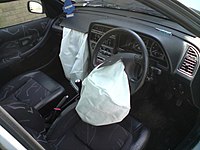
Photo from wikipedia
Low-rank decomposition model has been widely used in fabric defect detection, where a matrix is decomposed into a low-rank matrix representing the defect-free region (background) of the image and a… Click to show full abstract
Low-rank decomposition model has been widely used in fabric defect detection, where a matrix is decomposed into a low-rank matrix representing the defect-free region (background) of the image and a sparse matrix identifying the defective region (foreground). Two shortcomings, however, still exist. First, the traditional low-rank decomposition model can only deal with Laplacian noise, ignoring Gaussian noise in the image region. Second, when textiles have periodic complex patterns, it is difficult for traditional models to separate the defective regions from the background. To address these problems, we propose a low-rank decomposition model with noise regularization and gradient information (G-NLR): 1) noise regularization, which characterizes the image noise part and enlarges the gaps between defective objects and background in the feature space. 2) The gradient information constrains the noise term adaptively according to the mutation degree of the current pixel point, so as to guide the matrix decomposition and reduce the noise misjudgment. This ensures the accuracy of detection results. We evaluate our model for fabric defect detection on the standard database including box-, star- and dot-patterns, and compare with four recent detection methods. Experimental results show that our method has good results in terms of recall rate and precision.
Journal Title: IEEE Access
Year Published: 2019
Link to full text (if available)
Share on Social Media: Sign Up to like & get
recommendations!